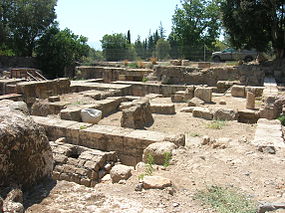Bible: What Does Mark 8 Teach Us About Sign-Seeking, Tradition, and Peter's "Great Confession of Faith"?
Jesus Feeds the Four Thousand

Jesus Feeds Thousands
Verses 1-10 record the account of the “Feeding of the Four Thousand.”
[Mark’s chronicle does not differ essentially from Matthew’s; confer with the commentary of the latter gospel (15:32-39).
Ryrie notes interestingly that the size of the baskets full of leftovers compares favorably with the kind in which believers lowered Paul at Damascus (cf. Acts 9:25).]
His response to the Pharisees seeking a sign contains three elements not found in Matthew.
First, Mark records that “He sighed deeply in His spirit” (v. 12a); second, he includes a rhetorical question the Lord posed regarding the leaders’ penchant for signs (v. 12b); and third, he omits mentioning that Jesus did intend to give this generation a sign—the sign of the prophet Jonah (cf. Matt. 16:4).
It seems as though the Lord might have given this answer before the Pharisees pressed Him for more.
To make them think, He illustrates their hypocrisy with the “signs of the times” imagery (see Matt. 16:1-3).
Magdala

Leaven
view quiz statisticsBethsaida

The False Teaching of the Pharisees
Christ does not spend much time in Dalmanutha (may be Magdala, a town southwest of Capernaum), but departs for “the other side” (v. 13).
On the journey, the disciples start discussing (and probably blaming one another for) their lack of bread; Mark writes that “they did not have more than one loaf” (v. 14).
His account of their conversation with Jesus about bread and leaven adds several elements to Matthew’s version, while omitting a few comments that the apostle inserts.
First, Mark omits Matthew’s “O you of little faith,” but adds “Is your heart still hardened?” (v. 17), and “Having eyes, do you not see? And having ears, do you not hear? (v. 18).
Second, the way he records Jesus’ phrasing of His questions about the breaking of the loaves on the two separate feeding occasions also differs from Matthew’s (vv. 19-20; cf. Matt. 16:9-10).
Third, Mark puts one-word responses into the apostles’ collective mouth, while Matthew omits their answers (vv. 19-20).
Finally, unlike Matthew, Mark cuts short the rest of Jesus’ critical question about their lack of understanding, and does not indicate that they understood His meaning (v. 21; cf. Matt. 16: 11b-12).
[It would be interesting to hear how the dialogue all actually transpired.]
Mark now inserts an incident that occurred in Bethsaida before recording Peter’s famous confession of faith on the road to Caesarea Philippi (vv. 22-26).
An unspecified group begs Jesus to “touch” a blind man whom they have brought to Him (v. 22).
Instead of curing him in their sight, the Lord leads the man by the hand out of town and heals him in stages—perhaps a unique instance of such (vv. 23-25).
Afterwards, Christ tells him to go home, not to town to give witness to his healing (v. 26).
[The Bethsaidan group probably sought sensationalism—something Jesus studiously avoided.]
Caesarea Philippi

John the Baptist?
view quiz statisticsThe Great Profession of Faith
Jesus heads due north toward Caesarea Philippi with His apostles, and broaches the most important questions that He could ask.
The first query appears as merely a request for information: “Who do men say that I am?” (v. 27)
Obliging Him, the disciples share a variety of popular answers: John the Baptist (Herod’s conjecture); Elijah (offered [perhaps] because of Jesus’ miracles); and one of the prophets (given because of His strong preaching ministry) [v. 28].
Christ’s second inquiry pointedly asks them for their perspective.
As usual, Peter voices his opinion first and confesses Jesus as Messiah (v. 29).
[Writing to a Jewish audience that could better appreciate the title, Matthew adds “the Son of the living God” (16:16).
Mark also omits Jesus’ explanation that Peter had received revelation from the Father.
Again, the Apostle Peter (out of humility) did not want Mark to include this mountaintop experience in his gospel.]
Once more, the Lord warns them not to tell anyone about this truth (v. 30); God must reveal it to them as He did to Peter.
The Death and Resurrection of Jesus


Peter's Error and Jesus' Rebuke
His correct answer about Jesus’ identity as the Christ and his exalted position among the apostles aside (cf. Matt. 16: 18-19), Peter does not neglect to tell Mark to write about how he put his foot in his mouth again after the Lord predicted His passion—the murder and resurrection of the Son of Man (v. 31)—by rebuking that Messiah! (v. 32).
Foreign to the apostle’s thinking is the concept of a dying Son of Man/Messiah; consequently, he does his best to set the Lord straight.
What he does not expect in return, perhaps, is Jesus’ counter-rebuke, especially not with the label He assigns to him: Satan (adversary) [v. 33a].
Turning around to make sure the others are listening, Christ corrects Peter’s incomplete information, drilling home the distinction between God’s interests and man’s (v. 33b).
The death and resurrection of the Son of Man stand as essential elements in God’s program, while mankind’s earth-bound perspective only sees the Messiah’s triumph over oppressors.
Next, Mark takes up the necessity to follow Christ to the point of death (vv. 34-37).
[Matthew’s commentary contains a detailed discussion on this matter (cf. 16:24-27)].
What Matthew omits, however, is the notion of shame.
Those who do not courageously defend the Savior’s honor Jesus will shame at His parousia (v. 38).
The “reward” the Lord gives, then, may be a holy gaze of disappointment, not a hearty “Well done.”
© 2014 glynch1







